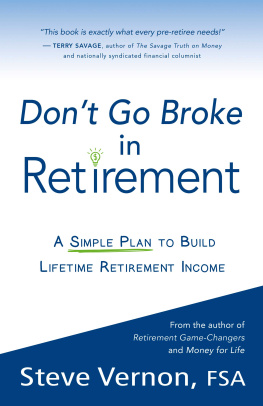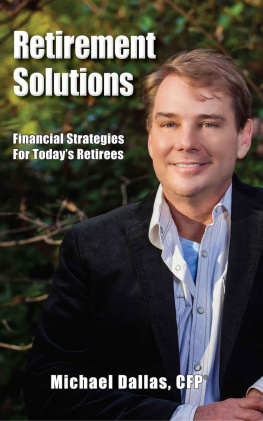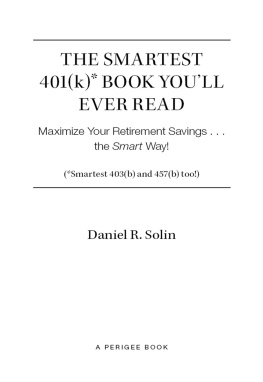

Copyright 2013 by Daniel Wildermuth. All rights reserved. Except as permitted under the United States Copyright Act of 1976, no part of this publication may be reproduced or distributed in any form or by any means, or stored in a database or retrieval system, without the prior written permission of the publisher.
ISBN: 978-0-07-180020-4
MHID: 0-07-180020-4
The material in this eBook also appears in the print version of this title: ISBN: 978-0-07-180019-8, MHID: 0-07-180019-0.
All trademarks are trademarks of their respective owners. Rather than put a trademark symbol after every occurrence of a trademarked name, we use names in an editorial fashion only, and to the benefit of the trademark owner, with no intention of infringement of the trademark. Where such designations appear in this book, they have been printed with initial caps.
McGraw-Hill eBooks are available at special quantity discounts to use as premiums and sales promotions, or for use in corporate training programs. To contact a representative please e-mail us at bulksales@mcgraw-hill.com.
TERMS OF USE
This is a copyrighted work and The McGraw-Hill Companies, Inc. (McGraw-Hill) and its licensors reserve all rights in and to the work. Use of this work is subject to these terms. Except as permitted under the Copyright Act of 1976 and the right to store and retrieve one copy of the work, you may not decompile, disassemble, reverse engineer, reproduce, modify, create derivative works based upon, transmit, distribute, disseminate, sell, publish or sublicense the work or any part of it without McGraw-Hills prior consent. You may use the work for your own noncommercial and personal use; any other use of the work is strictly prohibited. Your right to use the work may be terminated if you fail to comply with these terms.
THE WORK IS PROVIDED AS IS. McGRAW-HILL AND ITS LICENSORS MAKE NO GUARANTEES OR WARRANTIES AS TO THE ACCURACY, ADEQUACY OR COMPLETENESS OF OR RESULTS TO BE OBTAINED FROM USING THE WORK, INCLUDING ANY INFORMATION THAT CAN BE ACCESSED THROUGH THE WORK VIA HYPERLINK OR OTHERWISE, AND EXPRESSLY DISCLAIM ANY WARRANTY, EXPRESS OR IMPLIED, INCLUDING BUT NOT LIMITED TO IMPLIED WARRANTIES OF MERCHANTABILITY OR FITNESS FOR A PARTICULAR PURPOSE. McGraw-Hill and its licensors do not warrant or guarantee that the functions contained in the work will meet your requirements or that its operation will be uninterrupted or error free. Neither McGraw-Hill nor its licensors shall be liable to you or anyone else for any inaccuracy, error or omission, regardless of cause, in the work or for any damages resulting therefrom. McGraw-Hill has no responsibility for the content of any information accessed through the work. Under no circumstances shall McGraw-Hill and/or its licensors be liable for any indirect, incidental, special, punitive, consequential or similar damages that result from the use of or inability to use the work, even if any of them has been advised of the possibility of such damages. This limitation of liability shall apply to any claim or cause whatsoever whether such claim or cause arises in contract, tort or otherwise.
Contents
From the Author
Dear Reader,
Given todays volatility and complexity, successfully managing your finances if you are in or near retirement is more important than ever. Compared to just a decade ago, the amount of information, choices, possibilities, and potential problems is vastly greater. Issues such as income, growth, and risk of losses have always been important to anyone who is nearing or in retirement, and managing these challenges can be more difficult given todays volatile stock market, record low interest rates, and high probability of increasing inflation.
Fortunately, many of the same events that are generating todays challenges also create far more options and fantastic opportunities! In fact, todays investors enjoy unprecedented means to achieve financial success.
Before running through some explanations of possibilities, Ill acknowledge some challenges. The poor investment climate since the turn of the century may have tempted some people to limit their exposure to any risk, or even to abandon the world of investments altogether. Its been rough for many investors. Yet many, if not most, people who are nearing or in retirement have little choice but to keep their money working for them. Increasing life expectancies, greater expectations for retirement activities, ultra-low yields on safe or guaranteed investments, and higher future inflation expectations all make successful investing more important than ever.
Finding investment success may also appear elusive given the many problems constantly highlighted by journalists, politicians, pundits, and seemingly anyone with a platform from which to preach. The new millennium has already subjected investors to two severe stock market crashes, the 9/11 tragedy, European and U.S. debt problems, various bubbles and busts, corporate scandals, record low interest rates, vastly increased regulation, and dramatically increased volatility. The list of challenges is already long and will undoubtedly grow. For some investors, the future may not look much brighter, and some people have lowered their expectations for their personal finances and investments.
Yet, tremendous changes in financial markets are opening up many new opportunities, and the many problems over the past decade plus have also created a much more inviting investment climate. Just a few reasons for my optimism will help to explain this.
First, most investors continue to follow very traditional and dated investment strategies. They have not taken basic steps to shield themselves from the inevitable problems, nor have they positioned themselves to benefit from vastly expanded opportunities. Low interest rates and expected future increases in inflation further emphasize the limitations of traditional approaches, especially for investors who are in or near retirement.
These traditional and dated strategies contrast sharply with the more advanced approaches employed by college endowments, various institutions such as pension funds, and high-net-worth investors. These more sophisticated investors dramatically altered their investment strategies years ago and have generally enjoyed tremendous success since the turn of the century, while facing the same circumstances as individual investors. Investment strategies and even specific investments pursued by these more sophisticated investors are increasingly becoming available to individuals with portfolios of nearly any size. This factor alone offers tremendous potential for any investor to dramatically increase the likelihood of investment success and was the focus of my last book (Wise Money: Minimize Your Volatility and Increase your Control, McGraw-Hill, 2012).
Second, as of this writing, most assets with strong performance potential, such as stocks, real assets such as including real estate, and new debt instruments that are filling the void left by damaged credit markets, are priced below their historical averages. By this, I mean that it takes less money than is normally required to buy a given dollar of earnings capability, whether the dollar of profit comes from stocks, real estate, private equity, or various nontraditional debt instruments. When valuationsthe price required to buy a given dollar of earningsare low, future returns tend to be strong. This situation contrasts sharply with the circumstances in the late 1990s, when stock valuations hit record highs, setting the stage for terrible performance in the ensuing decade.
Next page








